
Wall customization in interior designing is one of the most significant elements that needs to set the tone and ambiance for any room. Of all these techniques, there is nothing that can top using texture paint in creating an aesthetic look for any space. Unlike ordinary paint, texture paint creates dimensions and depth on walls and turns a mere flat surface into an artefact. This technique has a world of possibilities to it – a wide variety of finishes and designs that could reflect your personal style, enhance your overall aesthetic, and even the durability of your walls.
Whether you’re designing a contemporary home, a rustic retreat, or an elegant office space, texture paint provides a versatile and cost-effective solution for customization. In combination with decorative paint techniques, it can create extraordinary results that not only enhance the visual appeal of a room but also make it feel more dynamic and inviting.
1. Texture Paint: The Art of Customizing Walls
Endless Design Possibilities
One of the strongest features of texture paint is its sheer number of options. Ranging from smooth, subtle finishes to bold, intricate patterns, texture paint will allow you to add an artistic flair to almost any surface. It’s not just about the color but also the textures that can play with light and shadow and give your walls a richly multi-dimensional look.
You can use a variety of techniques, such as sponging, brushed pearl, stucco, or even metallic finishes, to achieve the desired effect. With texture paint, your walls can take on the appearance of natural stone, fabric, or even aged plaster, making them a focal point in the room.
Besides, while mixed with other decorative paint, its effects can easily be multiplied creating designs that stand out in simple details. These include an expression of wall’s texture that produces a sense behind a book shelf, sophisticated sense of an area, or at times even cozier to step into if teamed with decorative painting accents.
Tailored to your needs and personal style
Texture paint is also very adaptable, and you can really use it for just about any design style you want, whether modern minimalist and trendy, or simply more classic and traditional. The best part of using texture paint for customization is that its application is highly flexible and can be modified to different architectural elements.
For example, a smooth, clean texture paired with decorative paint highlights may look sleek and refined in a modern home. Meanwhile, in a more rural application, a textured, stucco-like quality accompanied by earthy tones of decorative paint adds to the coziness and warmth that walls are known to offer. This versatility offers homeowners and designers the chance to get that ultimate balance of functionality and aesthetic.
2. Pragmatic Benefits of Texture Paint for Wall Customization
Durability and Protection
Not only is it aesthetically pleasing, but texture paint is also extremely tough. It would cover any small imperfections such as cracks and uneven spots in the wall. Hence, it makes a good fit for older walls or even walls that are broken and require patchwork. It would not be too easily scratched compared to flat paints since texture paints are harder, hence withstanding knocks, scratches, and scuffs more.
An additional coat of texture paint enhances the applied wall surface with a protective layer that helps with insulation of the walls and makes it more resistant to moisture and environmental effects. This feature particularly makes it suitable for much-traveled zones, the bathroom, kitchen, or even the exterior where walls face tough conditions.
Easy Maintenance and Cleaning
Texture-painted walls are easier to maintain compared to typical painted walls. The texture itself helps to conceal dirt, fingerprints, and stains. This means cleaning is easier and less frequent. For children’s playrooms or office spaces where walls are easily dirty, textured paint can be a practical solution without sacrificing style. You can also ensure that your textured walls stay vibrant and fresh for years by choosing the right decorative paint finish.
Conclusion:
Texture paint is an unbeatable source of benefits for personalizing your living or working space. Adding dimension, creating depth, and generally enhancing the aesthetic, texture paint is a necessary tool in any wall customization project. In combination with decorative paint, it will make your walls not just plain surfaces but an artistic expression of your taste and style.
Not only does texture paint provide endless creative possibilities, but it also delivers functional benefits such as durability, easy maintenance, and protection from everyday wear. Whether you’re aiming for a contemporary vibe, a rustic charm, or a sophisticated look, texture paint is the ultimate solution to create unique, customized walls that truly stand out.



